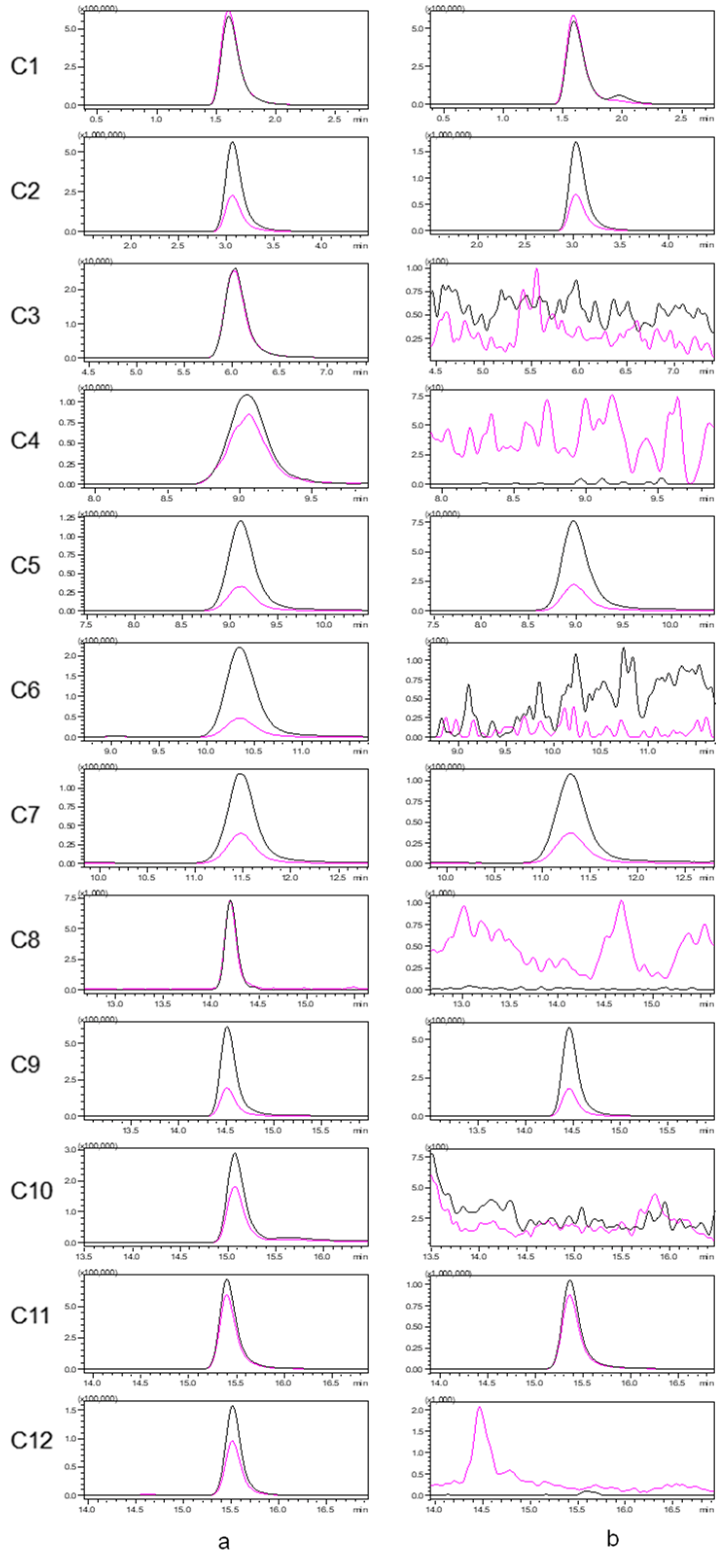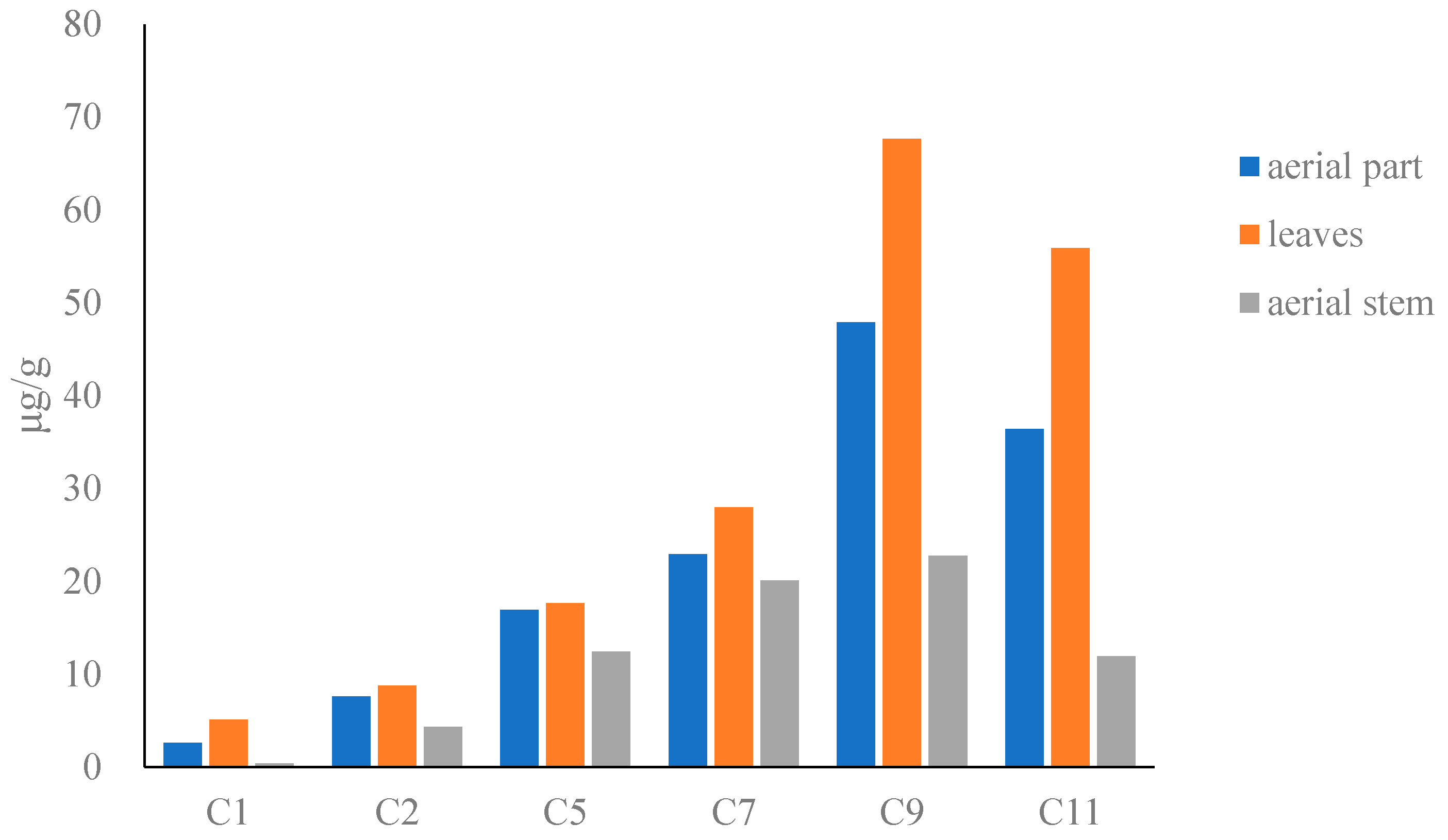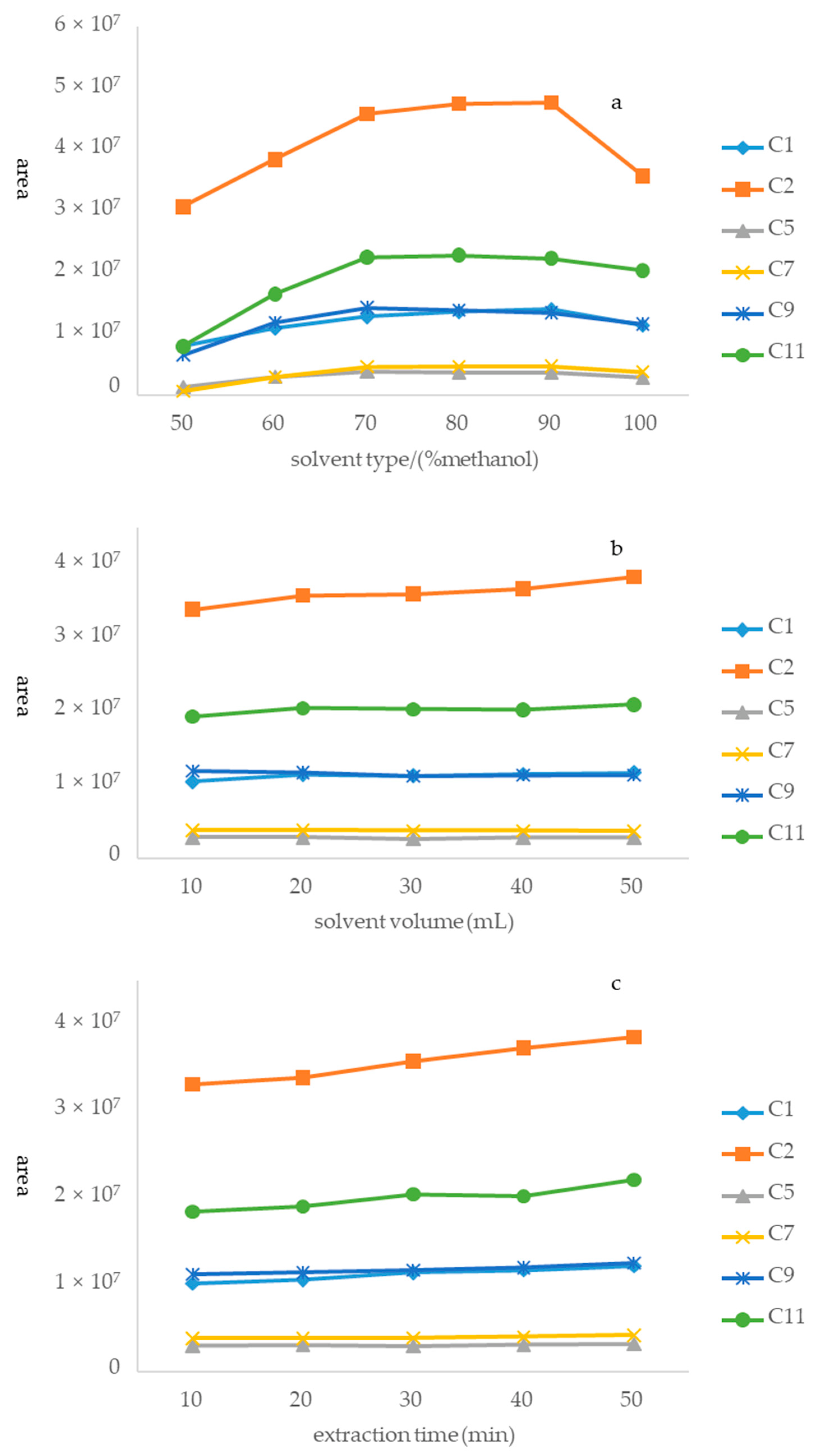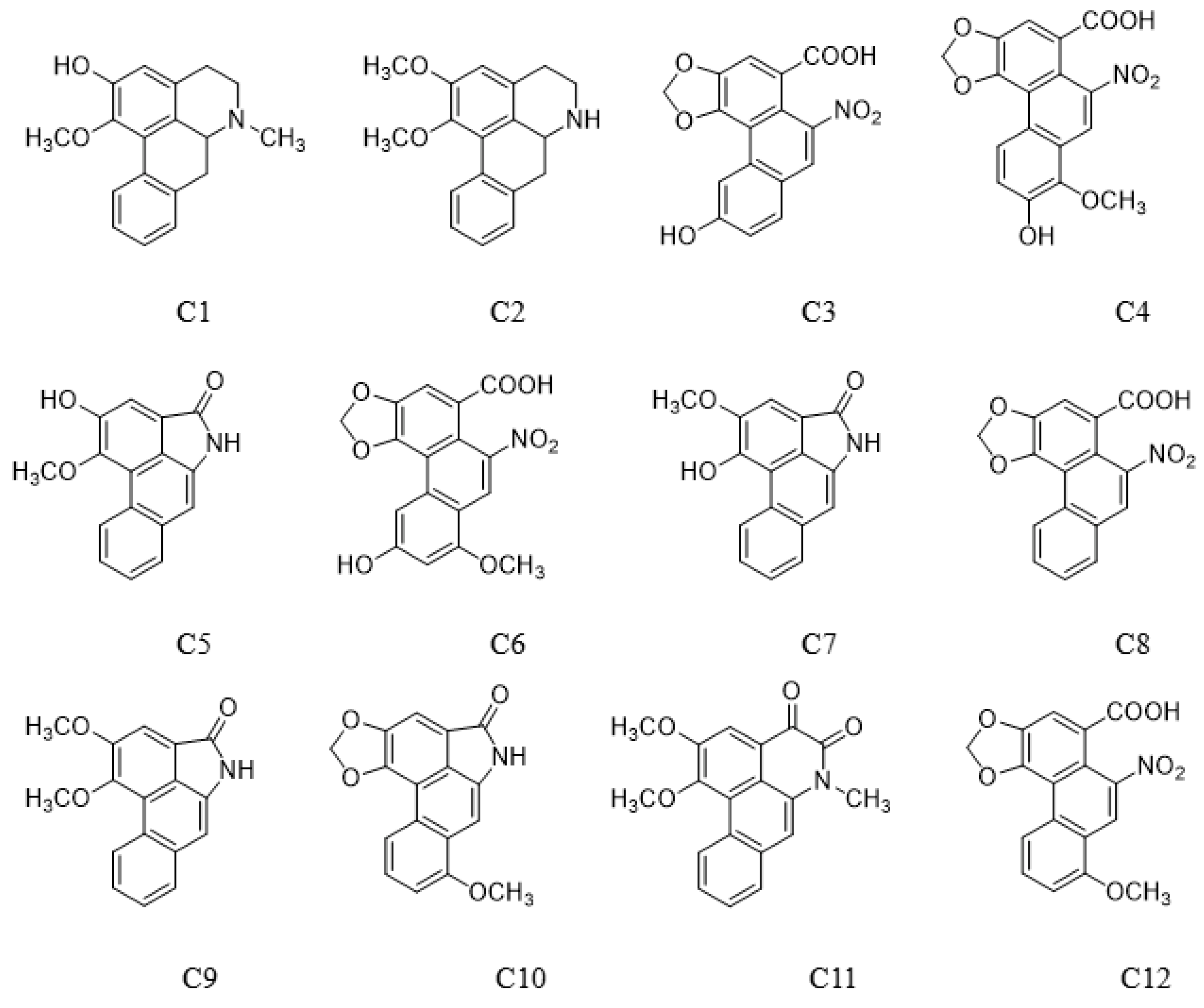Rapid Analysis of Aristolochic Acids and Aristolactams in Houttuyniae Herba by LC–MS/MS
Abstract
1. Introduction
2. Results
2.1. Linearity Range, Limits of Detection (LODs), and Limits of Quantification (LOQs)
2.2. Precision
2.3. Stability and Repeatability
2.4. Recovery
2.5. Sample Analysis
3. Discussion
3.1. Optimization of the Extraction Method Optimization of MS Conditions
3.2. Optimization of LC–MS/MS Conditions
4. Materials and Methods
4.1. Chemicals and Reagents
4.2. Samples
4.3. Instrumentation
4.4. Preparation of Standard Solutions
4.5. Sample Preparation
4.6. HPLC Chromatographic Conditions, Instruments, and Analytical Conditions
4.7. MS Conditions
5. Conclusions
Supplementary Materials
Author Contributions
Funding
Institutional Review Board Statement
Informed Consent Statement
Data Availability Statement
Conflicts of Interest
Sample Availability
References
- He, J.; Peng, L.; Li, W.; Luo, J.; Li, Q.; Zeng, H.; Ali, M.; Long, C. Traditional knowledge of edible plants used as flavoring for fish-grilling in Southeast Guizhou, China. J. Ethnobiol. Ethnomed. 2022, 18, 19. [Google Scholar] [CrossRef] [PubMed]
- Jin, L.; Yang, J.; Liu, C.; He, M.; Yan, H. Complete plastome of Houttuynia cordata (Saururaceae), a medicinal and edible plant. Mitochondrial DNA Part B 2019, 4, 3208–3209. [Google Scholar] [CrossRef] [PubMed]
- Zhu, B.; Feng, Q.; Yu, J.; Yu, Y.; Zhu, X.; Wang, Y.; Guo, J.; Hu, X.; Cai, M. Chloroplast genome features of an important medicinal and edible plant: Houttuynia cordata (Saururaceae). PLoS ONE 2020, 15, e0239823. [Google Scholar] [CrossRef] [PubMed]
- Chen, X.; Wang, Z.; Yang, Z.; Wang, J.; Xu, Y.; Tan, R.X.; Li, E. Houttuynia cordata blocks HSV infection through inhibition of NF-κB activation. Antivir. Res. 2011, 92, 341–345. [Google Scholar] [CrossRef] [PubMed]
- Lee, J.H.; Ahn, J.; Kim, J.W.; Lee, S.G.; Kim, H.P. Flavonoids from the aerial parts of Houttuynia cordata attenuate lung inflammation in mice. Arch. Pharm. Res. 2015, 38, 1304–1311. [Google Scholar] [CrossRef] [PubMed]
- Kim, J.M.; Hwang, I.H.; Jang, I.S.; Kim, M.; Bang, I.S.; Park, S.J.; Chung, Y.J.; Joo, J.C.; Lee, M.G. Houttuynia cordata Thunb promotes activation of HIF-1A–FOXO3 and MEF2A pathways to induce apoptosis in human HepG2 hepatocellular carcinoma cells. Integr. Cancer Ther. 2017, 16, 360–372. [Google Scholar] [CrossRef] [PubMed]
- Lu, Y.; Jiang, Y.; Ling, L.; Zhang, Y.; Li, H.; Chen, D. Beneficial effects of Houttuynia cordata polysaccharides on “two-hit” acute lung injury and endotoxic fever in rats associated with anti-complementary activities. Acta Pharm. Sin. B 2018, 8, 218–227. [Google Scholar] [CrossRef] [PubMed]
- Yanarojana, M.; Nararatwanchai, T.; Thairat, S.; Tancharoen, S. Antiproliferative activity and induction of apoptosis in human melanoma cells by Houttuynia cordata Thunb Extract. Anticancer Res. 2017, 37, 6619–6628. [Google Scholar] [PubMed]
- Wu, Y.; Ding, Q.; Liu, J.; Dai, Z.; Ma, S. Research progress on chemical components, pharmacology and quality control of Houttuyniae Herba. Chin. J. Pharm. Anal. 2022, 42, 108–120. [Google Scholar]
- Chou, S.C.; Su, C.R.; Ku, Y.C.; Wu, T.S. The Constituents and their bioactivities of Houttuynia cordata. Chem. Pharm. Bull. 2009, 57, 1227–1230. [Google Scholar] [CrossRef] [PubMed]
- Ma, Q.; Wei, R.; Wang, Z.; Liu, W.; Sang, Z.; Li, Y.; Huang, H. Bioactive alkaloids from the aerial parts of Houttuynia cordata. J. Ethnopharmacol. 2017, 195, 166–172. [Google Scholar] [CrossRef] [PubMed]
- Wei, Q.U.; Fei-Hua, W.U.; Juan, L.I.; Liang, J.Y. Alkaloids from Houttuynia cordata and their antiplatelet aggregation activities. Chin. J. Nat. Med. 2011, 9, 425–428. [Google Scholar]
- Michl, J.; Ingrouille, M.J.; Simmonds, M.S.; Heinrich, M. Naturally occurring aristolochic acid analogues and their toxicities. Nat. Prod. Res. 2014, 31, 676–693. [Google Scholar] [CrossRef] [PubMed]
- Li, X.L.; Guo, X.Q.; Wang, H.R.; Chen, T.; Mei, N. Aristolochic acid-induced genotoxicity and toxicogenomic changes in rodents. J. Tradit. Chin. Med. 2020, 6, 12–25. [Google Scholar]
- Ng, A.W.; Poon, S.L.; Huang, M.N.; Lim, J.Q.; Boot, A.; Yu, W.; Suzuki, Y.; Thangaraju, S.; Ng, C.C.; Tan, P.; et al. Aristolochic acids and their derivatives are widely implicated in liver cancers in Taiwan and throughout Asia. Sci. Transl. Med. 2017, 9, eaan6446. [Google Scholar] [CrossRef] [PubMed]
- Liu, J.; Guo, R.; Dai, Z.; Ma, S. Research progress on aristolochic acids. Mod. Tradit. Chin. Med. Mater. Med-World Sci. Technol. 2019, 21, 1280–1286. [Google Scholar]
- Chan, C.K.; Pan, G.; Chan, W. Analysis of aristolochic acids in Houttuynia cordata by liquid chromatography–tandem mass spectrometry. J. Mass Spectrom. 2020, 56, e4652. [Google Scholar] [CrossRef] [PubMed]
- Liu, J.; Liu, Y.; Wu, Y.; Dai, Z.; Ma, S. Rapid analysis of aristolochic acid analogues in traditional chinese patent medicine by LC-MS/MS. J. Anal. Methods Chem. 2020, 2020, 8823596. [Google Scholar] [CrossRef]





| Regression Equation | Linear Range (ng/mL) | R2 | LOD (ng/mL) | LOQ (ng/mL) | |
|---|---|---|---|---|---|
| C1 | y = 74,817.72 × x + 203.01 | 1.8~88 | 0.9999 | 0.035 | 0.116 |
| C2 | y = 85,419.58 × x + 589.94 | 15~760 | 0.9998 | 0.03 | 0.099 |
| C3 | y = 10,317.74 × x + 278.40 | 400~8000 | 0.9986 | 3.992 | 13.174 |
| C4 | y = 17.13 × x − 13349.20 | 270~5400 | 0.9997 | 2.684 | 8.857 |
| C5 | y = 184.43 × x + 170.21 | 18~910 | 0.9996 | 0.365 | 1.205 |
| C6 | y = 7102.95 × x + 184.16 | 270~5400 | 0.9994 | 2.687 | 8.867 |
| C7 | y = 141.62 × x + 69.29 | 22~890 | 0.9998 | 0.445 | 1.469 |
| C8 | y = 17,187.75 × x + 158.01 | 990~9900 | 0.9911 | 3.945 | 13.019 |
| C9 | y = 4601.52 × x + 354.20 | 80~4000 | 0.9999 | 0.402 | 1.327 |
| C10 | y = 18,862 × x + 342.51 | 41~830 | 0.9994 | 0.166 | 0.548 |
| C11 | y = 3453.48 × x + 124.20 | 42~1700 | 0.9995 | 0.166 | 0.548 |
| C12 | y = 1265.59 × x − 3289.37 | 260~5100 | 0.9994 | 2.569 | 8.478 |
| Repeatability | Stability | Precision RSD% | |||
|---|---|---|---|---|---|
| Average Content (μg/g) | RSD% | 1-2-4-8-12-24h (n = 6) | Intra-Day (n = 6) | Inter-Day( n = 9) | |
| C1 | 2.34 | 2.8 | 2.2 | 3.5 | 3.0 |
| C2 | 7.48 | 2.3 | 1.9 | 2.4 | 2.4 |
| C3 | 74.3 | 4.8 | 4.5 | 3.4 | 4.8 |
| C4 | 50.9 | 4.6 | 3.4 | 3.3 | 3.0 |
| C5 | 9.91 | 3.9 | 2.0 | 3.0 | 2.9 |
| C6 | 57.7 | 2.4 | 1.5 | 2.0 | 1.1 |
| C7 | 6.49 | 5.8 | 1.3 | 1.3 | 2.5 |
| C8 | 111 | 2.6 | 3.9 | 1.6 | 3.0 |
| C9 | 32.9 | 3.3 | 2.2 | 2.25 | 1.1 |
| C10 | 7.60 | 1.4 | 2.4 | 2.0 | 1.8 |
| C11 | 17.9 | 3.5 | 5.6 | 2.3 | 4.7 |
| C12 | 38.5 | 1.4 | 3.4 | 2.1 | 2.5 |
| Sample Number | Location | Parts | Sample Number | Location | Parts |
|---|---|---|---|---|---|
| S1 | Yibin, Sichuan Province, China | aerial part | S39 | Guanghan, Sichuan Province, China | leaves |
| S2 | Enshi, Hubei Province, China | aerial part | S40 | Qionglai, Sichuan Province, China | leaves |
| S3 | Henan Province, China | aerial part | S41 | Sichuan Province, China | leaves |
| S4 | Shiyan, Hubei Province, China | aerial part | S42 | Sichuan Province, China | leaves |
| S5 | Kaili, Guizhou Province, China | aerial part | S43 | Chongqing, China | leaves |
| S6 | Leshan, Sichuan Province, China | aerial part | S44 | Hubei Province, China | leaves |
| S7 | Shifang, Sichuan Province, China | aerial part | S45 | Sichuan Province, China | leaves |
| S8 | Guanghan, Sichuan Province, China | aerial part | S46 | Sichuan Province, China | leaves |
| S9 | Qionglai, Sichuan Province, China | aerial part | S47 | Qingtian, Zhejiang Province, China | leaves |
| S10 | Sichuan Province, China | aerial part | S48 | Qingtian, Zhejiang Province, China | leaves |
| S11 | Sichuan Province, China | aerial part | S49 | Hangzhou, Zhejiang Province, China | leaves |
| S12 | Chongqing, China | aerial part | S50 | Yunnan Province, China | leaves |
| S13 | Hubei Province, China | aerial part | S51 | Yaan, Sichuan Province, China | leaves (fresh) |
| S14 | Sichuan Province, China | aerial part | S52 | Yaan, Sichuan Province, China | leaves (fresh) |
| S15 | Sichuan Province, China | aerial part | S53 | Yaan, Sichuan Province, China | leaves (fresh) |
| S16 | Beijing, China | underground stem (fresh) | S54 | Yibin, Sichuan Province, China | aerial stem |
| S17 | Qingtian, Zhejiang Province, China | aerial part | S55 | Enshi, Hubei Province, China | aerial stem |
| S18 | Qingtian, Zhejiang Province, China | aerial part | S56 | Henan Province, China | aerial stem |
| S19 | Hangzhou, Zhejiang Province, China | aerial part | S57 | Shiyan, Hubei Province, China | aerial stem |
| S20 | Yunnan Province, China | aerial part | S58 | Kaili, Guizhou Province, China | aerial stem |
| S21 | Yaan, Sichuan Province, China | aerial part (fresh) | S59 | Leshan, Sichuan Province, China | aerial stem |
| S22 | Yaan, Sichuan Province, China | aerial part(fresh) | S60 | Shifang, Sichuan Province, China | aerial stem |
| S23 | Yaan, Sichuan Province, China | aerial part (fresh) | S61 | Guanghan, Sichuan Province, China | aerial stem |
| S24 | Zunyi, Guizhou Province, China | underground stem (fresh) | S62 | Qionglai, Sichuan Province, China | aerial stem |
| S25 | Guiyang, Guizhou Province, China | underground stem (fresh) | S63 | Sichuan Province, China | aerial stem |
| S26 | Bijie, Guizhou Province, China | underground stem (fresh) | S64 | Sichuan Province, China | aerial stem |
| S27 | Shifang, Sichuan Province, China | whole plant (fresh) | S65 | Chongqing, China | aerial stem |
| S28 | Shifang, Sichuan Province, China | whole plant (fresh) | S66 | Hubei Province, China | aerial stem |
| S29 | Shifang, Sichuan Province, China | whole plant (fresh) | S67 | Sichuan Province, China | aerial stem |
| S30 | Shifang, Sichuan Province, China | whole plant (fresh) | S68 | Sichuan Province, China | aerial stem |
| S31 | Shifang, Sichuan Province, China | whole plant (fresh) | S69 | Qingtian, Zhejiang Province, China | aerial stem |
| S32 | Yibin, Sichuan Province, China | leaves | S70 | Qingtian, Zhejiang Province, China | aerial stem |
| S33 | Enshi, Hubei Province, China | leaves | S71 | Hangzhou, Zhejiang Province, China | aerial stem |
| S34 | Henan Province, China | leaves | S72 | Yunnan Province, China | aerial stem |
| S35 | Shiyan, Hubei Province, China | leaves | S73 | Yaan, Sichuan Province, China | aerial stem (fresh) |
| S36 | Kaili, Guizhou Province, China | leaves | S74 | Yaan, Sichuan Province, China | aerial stem (fresh) |
| S37 | Leshan, Sichuan Province, China | leaves | S75 | Yaan, Sichuan Province, China | aerial stem (fresh) |
| S38 | Shifang, Sichuan Province, China | leaves |
| Retention Time (min) | Precursor Ion (m/z) | Product Ion (m/z) | Q1 Pre-Rod Bias (V) | CE (eV) | Q3 Pre-Rod Bias (V) | |
|---|---|---|---|---|---|---|
| C1 | 1.59 | 282.0 | 251.1 * | −14 | −17 | −29 |
| 219.1 | −14 | −19 | −26 | |||
| C2 | 3.00 | 282.0 | 265.1 * | −21 | −15 | −20 |
| 250.1 | −15 | −21 | −29 | |||
| C3 | 5.94 | 344.9 | 282.0 * | −28 | −15 | −12 |
| 283.9 | −27 | −14 | −21 | |||
| C4 | 8.92 | 374.9 | 314.1 * | −18 | −13 | −17 |
| 340.1 | −30 | −15 | −19 | |||
| C5 | 8.97 | 266.0 | 251.1 * | −28 | −23 | −29 |
| 195.1 | −28 | −31 | −23 | |||
| C6 | 10.21 | 374.9 | 312.0 * | −29 | −18 | −24 |
| 297.0 | −30 | −32 | −23 | |||
| C7 | 11.42 | 266.0 | 251.1 * | −28 | −23 | −29 |
| 195.1 | −28 | −31 | −23 | |||
| C8 | 14.17 | 329.0 | 268.1 * | −16 | −11 | −21 |
| 294.0 | −14 | −16 | −22 | |||
| C9 | 14.50 | 279.9 | 264.1 * | −23 | −26 | −30 |
| 236.1 | −23 | −28 | −18 | |||
| C10 | 14.99 | 294.0 | 278.9 * | −25 | −29 | −20 |
| 251.1 | −12 | −35 | −14 | |||
| C11 | 15.40 | 322.0 | 306.0 * | −17 | −29 | −23 |
| 278.1 | −17 | −29 | −21 | |||
| C12 | 15.45 | 359.0 | 298.1 * | −14 | −12 | −16 |
| 296.1 | −14 | −15 | −22 |
Publisher’s Note: MDPI stays neutral with regard to jurisdictional claims in published maps and institutional affiliations. |
© 2022 by the authors. Licensee MDPI, Basel, Switzerland. This article is an open access article distributed under the terms and conditions of the Creative Commons Attribution (CC BY) license (https://creativecommons.org/licenses/by/4.0/).
Share and Cite
Wu, Y.; Liu, J.; Kang, S.; Dai, Z.; Ma, S. Rapid Analysis of Aristolochic Acids and Aristolactams in Houttuyniae Herba by LC–MS/MS. Molecules 2022, 27, 8969. https://doi.org/10.3390/molecules27248969
Wu Y, Liu J, Kang S, Dai Z, Ma S. Rapid Analysis of Aristolochic Acids and Aristolactams in Houttuyniae Herba by LC–MS/MS. Molecules. 2022; 27(24):8969. https://doi.org/10.3390/molecules27248969
Chicago/Turabian StyleWu, Yingxue, Jing Liu, Shuai Kang, Zhong Dai, and Shuangcheng Ma. 2022. "Rapid Analysis of Aristolochic Acids and Aristolactams in Houttuyniae Herba by LC–MS/MS" Molecules 27, no. 24: 8969. https://doi.org/10.3390/molecules27248969
APA StyleWu, Y., Liu, J., Kang, S., Dai, Z., & Ma, S. (2022). Rapid Analysis of Aristolochic Acids and Aristolactams in Houttuyniae Herba by LC–MS/MS. Molecules, 27(24), 8969. https://doi.org/10.3390/molecules27248969






